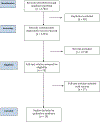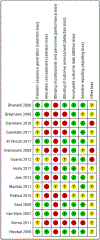Oral vs intravenous iron therapy for postpartum anemia: a systematic review and meta-analysis
- PMID: 30578747
- PMCID: PMC7060493
- DOI: 10.1016/j.ajog.2018.12.016
Oral vs intravenous iron therapy for postpartum anemia: a systematic review and meta-analysis
Abstract
Objective: To perform a systematic review of randomized trials comparing oral vs intravenous (IV) iron therapy to treat postpartum anemia.
Data sources: Data sources were as follows: PubMed (1972-2017); Cochrane Central Register of Controlled Trials, CENTRAL (1972-2017); CINAHL (1972-2017); Web of Science; Excerpta Medica Database, and EMBASE (1972-2017).
Study eligibility criteria: We included randomized trials comparing oral vs IV iron monotherapy to treat postpartum anemia (classified as a hemoglobin <12 g/dL).
Study appraisal and synthesis methods: Study quality was assessed with the Cochrane risk of bias assessment tool. The primary outcome was hemoglobin concentration at 6 weeks postpartum. Secondary outcomes included hemoglobin concentration at 1-5 weeks postpartum, ferritin concentration at 1-6 weeks postpartum, and maternal adverse outcomes. For meta-analysis, mean differences and odds ratios using a random effects model were calculated. Risk of heterogeneity was reported as I2.
Results: A total of 15 randomized trials met our inclusion criteria (n = 1001 and 1 181 women receiving oral iron and IV iron, respectively); 4 studies reported data for our primary outcome. We observed higher postpartum week 6 hemoglobin concentrations in the IV iron group compared to the oral iron group (mean difference, 0.9 g/dL; 95% confidence interval (CI), 0.4-1.3; P = .0003). Compared to oral iron, women receiving IV iron had higher hemoglobin concentrations at postpartum weeks 1, 2, and 3; higher ferritin concentrations at postpartum weeks 1, 2, 4, and 6; an increased likelihood of skin flushing (odds ratio [OR], 6.95; 95% CI, 1.56-31.03; P = .01; I2 = 0%); and a decreased likelihood of constipation (OR, 0.08; 95% CI, 0.03-0.21; P < .00001, I2 = 27%) and dyspepsia (OR, 0.07; 95% confidence interval, 0.01-0.42; P = .004; I2 = 0%). The reported event rate for anaphylaxis among women receiving IV iron was 0.6%.
Conclusion: In this systematic review, among women with postpartum anemia, hemoglobin concentrations at 6 weeks postpartum were almost 1 g/dL higher in women who received IV iron compared to oral iron. The safety profile of IV iron was also reassuring. Given the weaker hemoglobin response and higher risk of gastrointestinal side effects with oral iron use, our findings suggest that IV iron be considered as a viable treatment option for postpartum iron deficiency anemia.
Keywords: anemia; iron; postpartum period.
Copyright © 2019 Elsevier Inc. All rights reserved.
Conflict of interest statement
Conflicts:
The authors have no conflicts of interest to declare.
Figures



References
-
- Corwin EJ, Murray-Kolb LE, Beard JL. Low hemoglobin level is a risk factor for postpartum depression. J Nutr 2003;133:4139–42. - PubMed
-
- Lee KA, Zaffke ME. Longitudinal changes in fatigue and energy during pregnancy and the postpartum period. J Obstet Gynecol Neonatal Nurs 1999;28:183–91. - PubMed
-
- Beard J, Hendricks M, Perez E, et al. Maternal iron deficiency anemia affects postpartum emotions and cognition J Nutr 2005;135:267–72. - PubMed
-
- Murray-Kolb LE, Beard JL. Iron deficiency and child and maternal health. Am J Clin Nutr 2009;89:946s–50s. - PubMed
Publication types
MeSH terms
Substances
Grants and funding
LinkOut - more resources
Full Text Sources
Other Literature Sources
Medical
Miscellaneous

